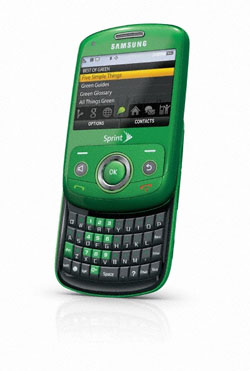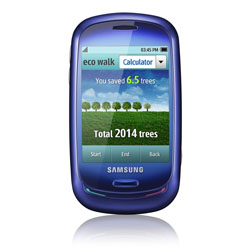 When it comes to creating a green office, you have to turn your attention to the devices that use a great deal of energy – the computers and servers. Even if you make a conscious effort to turn off your computer – or at least the monitor – after hours, computers are still the company workhorses and demand a lot of power.
When it comes to creating a green office, you have to turn your attention to the devices that use a great deal of energy – the computers and servers. Even if you make a conscious effort to turn off your computer – or at least the monitor – after hours, computers are still the company workhorses and demand a lot of power.Millions of Americans are tethered to their computers daily, so what can a business do to create greener software and computer solutions?
A good first step to look at how your company is using its software programs – on-site versus something calls SaaS or Software as a Service. Taking a green perspective on this topic, your business could be saving a great deal of energy by using SaaS or Web-based applications that run through the vender’s data center and are accessed online. On-site software means you pop in the CD, install the software and run it on your own server or computer hard drive.
Chris Thorman on SoftwareAdvice.com, offers an extensive comparison of the two and which one is more green. In his example, SaaS uses significantly less energy, in part because a vendor can accommodate multiple customers on one server, and off-site software requires less power meaning employees can switch to more energy-efficient personal computers, such as laptops.
Another benefit to using online software or shared downloads is the savings on packaging (no CD, no boxes) as well as the energy savings from not having those items delivered to your office via a delivery truck.
Here are a couple of other green computing options:
• Canadian-based computer Userful has created Userful Multiplier, which uses Linux-based software and allows 10 users to run off the juice of one computer. The company boasts a savings of 90% on electricity use with its product.
• Faronics Power Save analyzes your computer’s activities and powers down the computer when it’s inactive. The computer claims an average savings of $50 per computer per year when using this software solution.
 But if you’re still thinking, “OK, what’s all the hype? How much energy can my computer really use?”, check out this article on the power consumption of computers. It gives good evidence for switching to a laptop (15-60 watts) from a desktop (60-500 watts) for energy efficiency and turning off your monitor when it’s not in use (0-15 watts versus up to 150 watts when a monitor is running).
But if you’re still thinking, “OK, what’s all the hype? How much energy can my computer really use?”, check out this article on the power consumption of computers. It gives good evidence for switching to a laptop (15-60 watts) from a desktop (60-500 watts) for energy efficiency and turning off your monitor when it’s not in use (0-15 watts versus up to 150 watts when a monitor is running). In the end these extra efforts can ultimately save your business money as energy consumption drops and you can afford to upgrade to more energy-efficient computers for your employees. And that kind of green savings is something just about any business can get behind.
Let’s hear your ideas! What green computing solutions are you using?
[ 1 comment ] ( 334 views ) | [ 0 trackbacks ] | permalink |




 ( 3 / 2405 )
( 3 / 2405 )  By its very nature, working from home is a greener option. The commute involves simply walking from the kitchen with coffee mug in hand to your home office space – no vehicle emissions needed.
By its very nature, working from home is a greener option. The commute involves simply walking from the kitchen with coffee mug in hand to your home office space – no vehicle emissions needed. People who work from home also have more control over how they can green their space, such as opting for natural lighting instead of harsh fluorescent overhead lights or purchasing eco-friendly products, such as recycled paper or refilled ink cartridges.
A downside to working from home is not being around co-workers who (hopefully) would share your desire to make the workplace a little greener. But there are still some ways you can be part of a green community, even if your only office-mates are a cat and a dog.
• Be part of the green online community. Twitter, for example, is a great “water cooler” for people who work from home. If you need a five-minute break, join in the Twitter conversation and connect with other people with a passion for green. (The Green Office Blog is on Twitter too.)
• Join a local environment or conservation organization. A local nonprofit would welcome your interest and involvement and it’s a great way to meet new people who share your eco interest. Plus, you might find it’s good for business networking.
• If you happen to telecommute or work for a company in which a large number of employees work from home, create a virtual green team. Share resources and ideas for making each home office greener.
Here are some more good tips for a green home office from www.BestGreenHomeTips.com, including investing in a programmable thermostat. This means you have control of the office temperature, so no need to have the A/C cranked when it’s only 60 degrees outside.
Finally, think about the equipment you’re using at home. You have the freedom to select energy-efficient products, including your computer. An excellent resource is the Electronic Product Environmental Assessment Tool (EPEAT). A product of the Green Electronic Council, this program evaluates computer desktops, laptops and monitors based on 51 environmental criteria developed through an extensive process supported by the U.S. EPA.
Do you work at home? What are your suggestions for making your home office green?
[ 2 comments ] ( 191 views ) | [ 0 trackbacks ] | permalink |




 ( 3 / 2564 )
( 3 / 2564 ) Back in March, the Green Office Blog gave a Green Thumbs Up to Sprint for its efforts to create a more sustainable workplace. So when a company representative contacted me asking if I’d like to test drive the new Samsung Reclaim cell phone, I jumped at the chance to check it out.
 It arrived one afternoon in all its green glory, made from 80 percent recyclable materials. The Reclaim comes with a full slide-out keyboard, texting, e-mail and Internet capabilities. It is, as you might expect, available in Earth Green and Ocean Blue. At $50, it’s a robust phone with plenty of features most consumers expect from their cell phones today – camera, Facebook, MySpace and Google.
It arrived one afternoon in all its green glory, made from 80 percent recyclable materials. The Reclaim comes with a full slide-out keyboard, texting, e-mail and Internet capabilities. It is, as you might expect, available in Earth Green and Ocean Blue. At $50, it’s a robust phone with plenty of features most consumers expect from their cell phones today – camera, Facebook, MySpace and Google. At first I had a little bit of a tough time figuring out the navigation on the main screen and which button did what. (Granted, like I’m sure most people do, I just started pushing buttons and didn’t first pull out the instructions.) The keyboard worked surprisingly well considering I’m used to my Blackberry, which has a slightly larger keypad and raised keys, whereas the Reclaim has a flat keyboard.
Definitely for the price, the Reclaim is a good deal and has all the standard cell phone bells and whistles. But I really liked the added bonus of a number of green features, including a Green Glossary, Guide Guides and Five Simple Steps all from the Discovery Channel.
One of the neat green side benefits is that $2 from the proceeds of each Samsung Reclaim benefits The Nature Conservancy’s Adopt an Acre program, which supports land conservation across the United States.
A few more green tidbits about the Samsung Reclaim:
• The phone’s bio-plastic material is made from corn and comprises 40 percent of the outer casing.
• The box and packaging are made from 70 percent recycling materials and printed with soy-based ink.
• The charger is Energy Star approved and lets you know when the phone is fully charged.
• Included in the package is a paper filled with green facts about Sprint that can be soaked in water, planted and turned into wildflowers.
Here’s another review of the Reclaim from EngadgetMobile.com.
Other cell phone makers are taking a turn toward the green and creating cell phones that are both functional and eco-friendly. About.com ranked the top three green cell phones. The Reclaim is on the list along with the MOTO W233 Renew from T-Mobile. It’s made from recycled plastic water bottles, and Motorola claims it is the world’s first carbon-neutral phone.
 Also, the Samsung Blue Earth (pictured at right) is a green smartphone also made from recycled plastic water bottles. This phone charges not only with an energy-efficient charger but with solar panels (cool!). You can watch a video about this phone here.
Also, the Samsung Blue Earth (pictured at right) is a green smartphone also made from recycled plastic water bottles. This phone charges not only with an energy-efficient charger but with solar panels (cool!). You can watch a video about this phone here. Need more ideas for turning your cell phone green? Check out this Web site. And don’t forget to recycle your old cell phone when you upgrade.
Have you tried one of these green cell phones? Post a comment and let us know what you think.
[ add comment ] ( 287 views ) | [ 0 trackbacks ] | permalink |




 ( 3.1 / 50 )
( 3.1 / 50 )  "What does the world need most that we are uniquely able to provide?" That’s the question Jeffrey Hollender, Seventh Generation co-founder and chief inspired protagonist, poses on the company Web page heralding the release of its 2008 Corporate Conscious Report.
"What does the world need most that we are uniquely able to provide?" That’s the question Jeffrey Hollender, Seventh Generation co-founder and chief inspired protagonist, poses on the company Web page heralding the release of its 2008 Corporate Conscious Report. Seventh Generation, which makes environmentally friendly and natural household and personal care products, is a progressive and growing company. For a company that has long been looking ahead and measuring its success against the greater good, Hollender wonders about the future corporate social responsibility and its far-reaching impact on businesses.
…a growing breed of good companies has heard President Obama's call to a “new era of responsibility." Fueled by an emerging generation of business leaders, these companies are committed to merging economic growth with social justice. They view the financial crisis and the climate crisis as once-in-a-lifetime opportunities to unleash principled behavior for the greater good. For them, values and principles are sources of innovation—opportunities to create products and services that deliver a Return on Purpose as well as a Return on Investment.
And, so, we return to Hollender’s initial question about what the world needs that our business can uniquely provide. Thought-provoking discussion topics, no doubt.
This is a great time to step back and take a look at your own business and its impact on your local community, your state, your region and ultimately the world. For many companies, it means taking an initial step toward more recycling or reducing energy consumption in the office. For others, it could mean going further in its effort by selecting like-minded suppliers and vendors.
In this “new era responsibility,” more individuals are taking a stand for the environment and that means businesses have to get on board. It explains why a company like Seventh Generation is growing – its products and its corporate mission strike a cord with many consumers. Can the same be said for your business?
If your company had to put together a corporate responsibility report, what would it say? Post a comment and let us know how your office is making a difference.
For inspiration, check out the online book Seventh Generation is working on that highlights best practices in corporate social responsibility. The company has partnered up with Justmeans, an online network for responsible business, to explore how the growing breed of socially responsible companies can become a voice in shifting business as we know it. Stop by the Web site to submit your ideas to the book or to simply be inspired.
[ add comment ] ( 71 views ) | [ 0 trackbacks ] | permalink |




 ( 3 / 2535 )
( 3 / 2535 )  The stores are filled with crayons, markers, glue sticks and Hannah Montana notebooks. It’s back-to-school time. OK, so you’re not going back to school, you’re just headed back to the office for another wild work week. But you can turn this back-to-school time into an opportunity to introduce some green into the workplace.
The stores are filled with crayons, markers, glue sticks and Hannah Montana notebooks. It’s back-to-school time. OK, so you’re not going back to school, you’re just headed back to the office for another wild work week. But you can turn this back-to-school time into an opportunity to introduce some green into the workplace. Seems this time of the year is perfect for offices to take stock of their supply cabinets and look for ways to reduce consumption or switch at least a few items to more environmentally options.
• Paper clips made from recycled steel.
• Pencils made from blue jeans and newspaper.
• This looks neat: a staple-free stapler, which makes it easier to drop your paper in the recycling bin or use the blank sides of that 30-page report for printing without having to pick out the staples. Check it out here.
• Check out TerraCycle Inc. for a host of nifty office supplies made from recycled products. They have pouch pencil cases, folders and lunch boxes made from old juice boxes. And you’re sure to be the talk of the boardroom with a notebook made from an old Double Stuff Oreo wrapper.
These days it’s fairly easy to find recycled paper, notepads and Post-it Notes made of 30 percent postconsumer content (or more). In fact, just about all stores carry some environmentally friendly office supplies, and larger stores have devoted entire product lines to earth-friendly items, such as Staples EcoEasy and Office Deport Green.
But you carry this school concept beyond the office supplies. Try turning the next few weeks into a time to educate your co-workers, management and customers with a “back to school – green style” theme.
A couple of ideas to get you started:
• Pack your lunch. For one week, encourage all employees to bring their lunch. The catch is the lunches have to be sustainable – put food in reusable containers, bring a cloth napkin and pack some locally grown fruits or veggies.
• No printing week. Employees are allowed to print two sheets of paper a day, which gets them thinking about whether a document really needs printed.
• Community service grade. Invite a guest speaker or two from local environment groups to talk about their organizations and how employees can get involved, either individually as a company.
It’s a great chance to educate your co-workers about being more environmentally conscious and in a fun way. And, the best part: no final exams.
Ideas for how to educate your co-workers on going green? Post a comment and share your ideas.
[ 4 comments ] ( 1556 views ) | [ 0 trackbacks ] | permalink |




 ( 3.1 / 55 )
( 3.1 / 55 ) 


 Looking for a Green Office Solution?
Looking for a Green Office Solution?